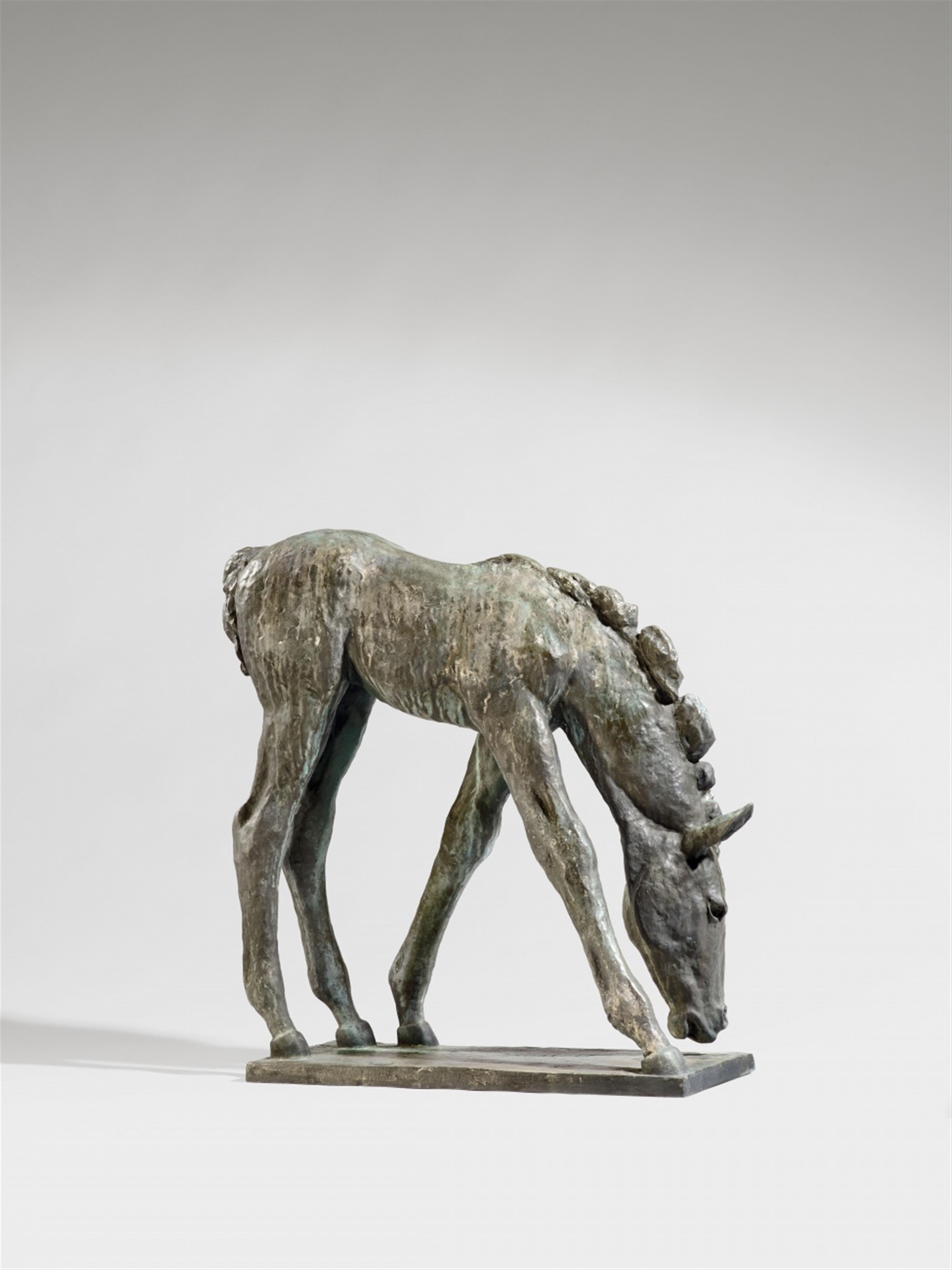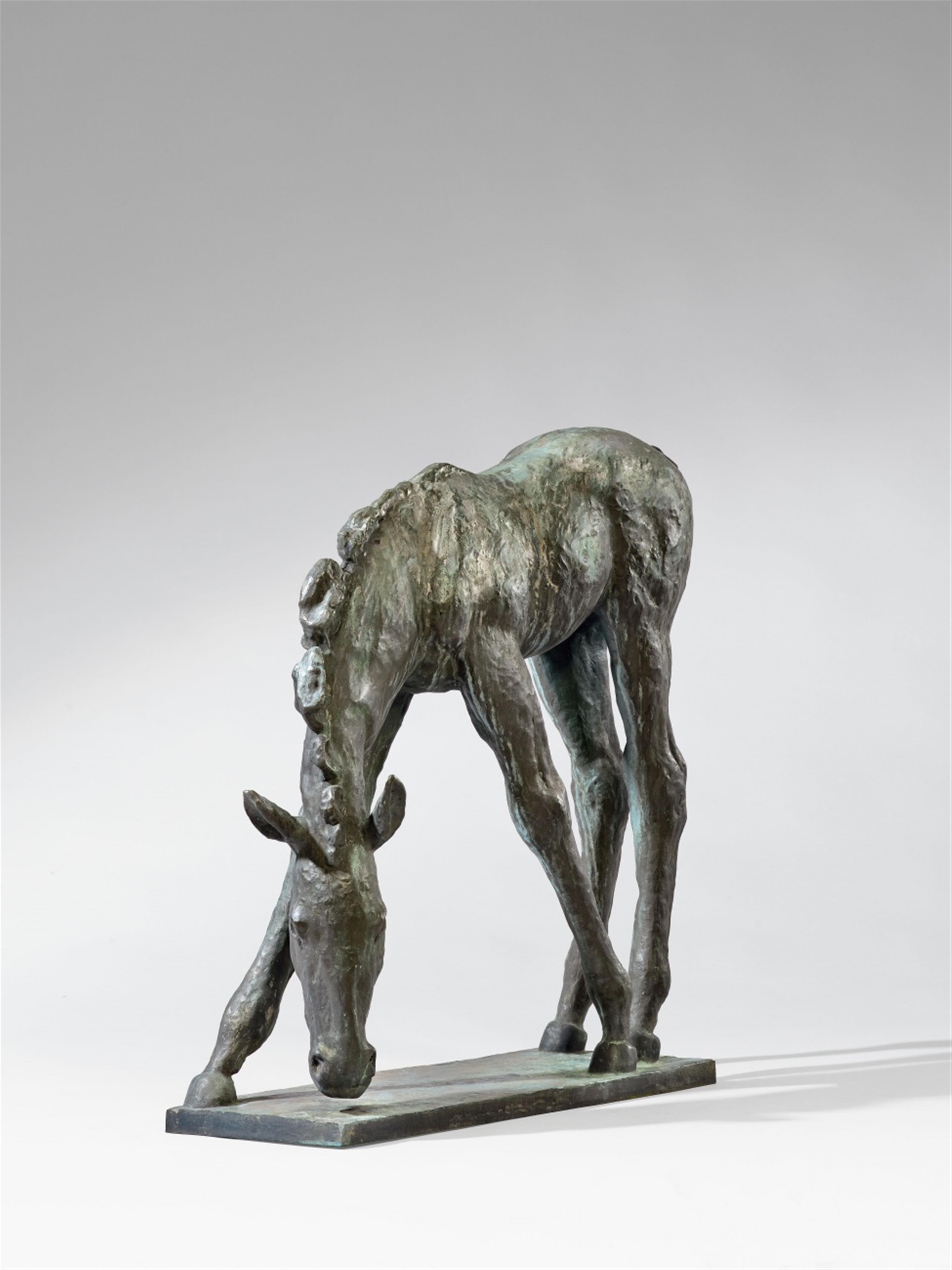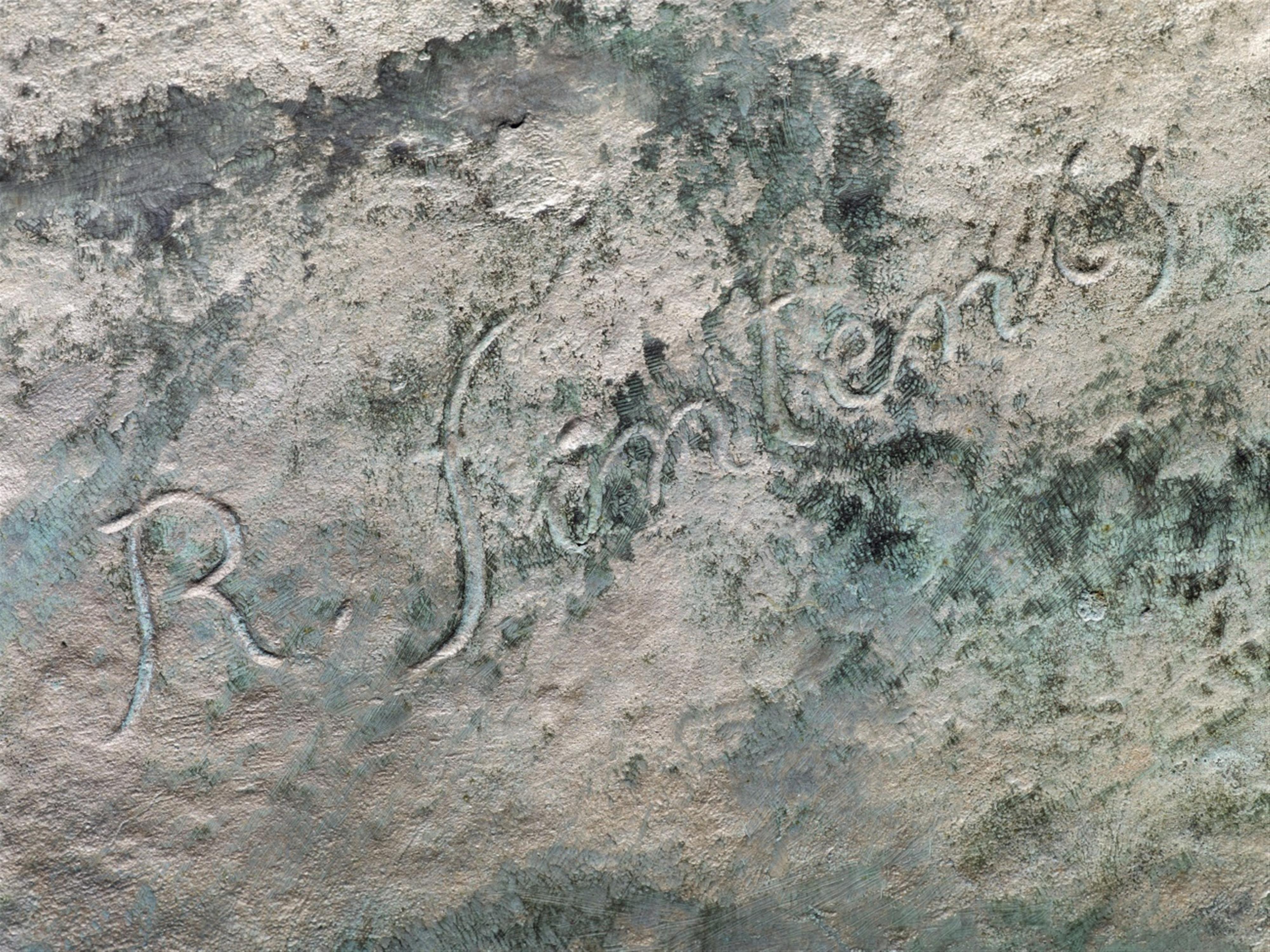Renée Sintenis
Großes grasendes Fohlen
1929
Bronze Height 76.3 cm Signed 'R. Sintenis' centrally on the cast-with plinth (64 x 26.5 x 3 cm). According to Ursel Berger, the present bronze without foundry mark was cast at Hermann Noack in Berlin, most likely before World War II. The piece is comparable with a cast in private possession that was originally installed in front of Galerie Flechtheim in Berlin and which might have been the first exemplar. René Crevel (1930) mentions casts in the collections of Max Emden, Ascona, Oskar Reinhart, Winterthur, and Hugo Borst, Stuttgart. Lifetime casts of this foal are very rare. - Greenish patina, partially silvery shimmer. - In very fine condition. - The bronze was installed outdoors for considerable time.
Of the approximately 125 animal bronzes created by Renée Sintenis, almost half are devoted to depictions of horses and ponies. The sculptor's particular fascination with foals is plainly apparent, and she modelled them in a great variety of temperaments and situations. She expresses her deep affection for this species of animals in these works - and this was also something she never sought to conceal. She freely admitted: “In the genuine sense of the word, an almost idolatrous love and adoration of horses lives in my heart. This inner veneration always appears to me to be filled all over again with a mysterious significance. I can't explain it with my rational mind [...] I almost feel I should say it is a metaphysical matter.” (cited in: exhib. cat. Georg-Kolbe-Museum (ed.), op. cit., Berlin 1983, p. 116). As a child the enthusiastic rider had already preferred to spend her time in paddocks and pastures, and it was presumably there that she gathered the first impressions for her rich repertoire of motifs.
Sintenis had already created a small previous version in 1919 (Berger/Ladwig 44; Buhlmann 130); ten years later she transferred the motif in a slightly modified form into the “Großes grasendes Fohlen”. The delicate young animal now bows its head downwards to the left, with its still spindly front legs stretched forwards and backwards, so that it can more easily reach its mouth to the ground. The hind legs provide it with support in this somewhat awkward position. The foal jauntily stretches its rump, with its still bushy short tail, into the air. Although it is entirely occupied with feeding, it simultaneously attempts to take in as many impressions as possible with its other sensory organs: nostrils, eyes and ears.
Here Sintenis has developed the physiognomic characteristics with great formal confidence - a remarkable further elaboration upon the initial, small version. Both children and adults can enjoy two casts of the “Großes grasendes Fohlen” in public spaces: since 1971, one lingers on Berlin's Renée-Sintenis-Platz and the other searches for food in Düsseldorf's Hofgarten.
Catalogue Raisonné
Berger/Ladwig 111; Buhlmann 139
Certificate
With an expertise by Ursel Berger, Berlin, dated 1 April 2016
Provenance
German private collection, Rhineland; Private collection, Lower Rhine (acquired from the former owner during the 1980s)
Literature
Der Querschnitt, no. 9, issue I, 1929, p. 340 with illus.; René Crevel, Renée Sintenis, Paris 1930, illus. p. 63 ("Le grand poulain"); René Crevel/Georg Biermann, Renée Sintenis, Junge Kunst vol. 57, Berlin 1930, no. 83 with illus. 31 ("Das grasende Fohlen"); Deutsche Kunst und Dekoration, no. 66, 1930, p. 38 with illus.; Kunst und Künstler, no. 28, 1930, p. 235 witth illus.; Ada Schmidt-Beil (ed.), Die Kultur der Frau. Eine Lebenssymphonie der Frau des XX. Jahrhunderts, Berlin 1931, p. 281 with illus.; Omnibus 1931, p. 54 with illus.; Dedalo, year 3, issue 13, 1933, p. 40 with illus.; Hanna Kiel, Renée Sintenis, Berlin 1935, p. 65 with full-page illus.; Rudolf Hagelstange (i.a.), Renée Sintenis, Berlin 1947, illus. no. 79 ("Großes Fohlen"); Adolf Jannasch, Renée Sintenis, Potsdam 1949, illus. no. 13 ("Grosses weidendes Fohlen"); The Studio, no. 138, 1949, p. 182 with illus.; Die Weltkunst, no. 23, issue 15, 1953, p. 9 with illus.; Hanna Kiel, Renée Sintenis, Berlin 1956, p. 41 with full-page illus.; Rudolf Koella, Sammlung Oskar Reinhart, Winterthur, Zurich 1975, p. 358 with illus.; Martin Damus und Henning Rogge, Fuchs im Busch und Bronzeflamme. Zeitgenössische Plastik in West-Berlin, Munich 1979, p. 127 with illus.
Exhibitions
Berlin 1930 (Berliner Secession), Plastik, 59th exhibition, without no.; Düsseldorf 1953 (Galeie Vömel), Sommerausstellung der Galerie Vömel; Berlin 1958 (Haus am Waldsee), Renée Sintenis, cat. no. 42; Düsseldorf 1965 (Galerie Vömel), Werke deutscher Bildhauer 1918 - 1939, illus. n. pag.; Düsseldorf 1978 (Galerie Vömel), Ausstellung von Skulpturen, Zeichnungen und graphischen Werken von Renée Sintenis zum 90. Geburtstag, illus. n. pag; Berlin/Osnabrück/Regensburg/Friedberg/Düren 1983/1984 (Georg-Kolbe-Museum/Kulturgeschichtliches Museum/Ostdeutsche Galerie/Galerie im Alten Rathaus/Leopold-Hoesch-Museum), Renée Sintenis. Plastiken, Zeichnungen, Druckgraphik, cat. no. 35 with illus. p. 66






